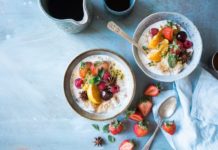
“Listen to your body” is good advice for the most part—when your body wants something perfectly reasonable, like a brisk walk. But other times, it can be problematic: what if your body is unmistakably telling you to eat a massive plate of french fries with gravy?
What’s with cravings?
A food craving is a strong desire for a specific item, either to experience its pleasant effects or to avoid unpleasant feelings of withdrawal. As long as you crave nutritious foods such as oranges or Swiss chard, everything’s fine and dandy. Yet it’s very common to crave foods that are a poor choice, health-wise: high-calorie foods such as pastries or potato chips, for example.
Scientists who study the biology of food intake have determined that cravings—also known as disruptions in normal feelings of satiety—depend on complex factors including hormones, food-related habits and cues, and stress levels. Even genetic factors can influence the hormones that keep you feeling satisfied and free of food cravings.
Lately, however, researchers have identified a potential new contributor to the experience of cravings: the gut microbiota, which is a community of bacteria, fungi, and other microbes living in your digestive tract.
The gut and the brain are closely connected through the gut-brain axis. Under some circumstances, gut bugs might influence the messages received by the brain. Thus, scientists have advanced the theory that in the harsh, competitive environment of the gut, some microbes may have developed last-ditch strategies to obtain the food that keeps them alive.
Potentially they’d do this by manipulating their host’s eating behaviour—producing mood-altering hormones, messing with taste receptors, or sending the nervous system an SOS signal through the vagus nerve.
While scientists caution that they still lack information on the mechanisms by which this could happen in humans, it turns out there’s evidence for a few basic ways to target your gut microbiota to tame unwelcome cravings.
Prebiotics and postbiotics
The powerhouses of craving control are called prebiotics: substrates used as food for your micro-organisms, conferring a health benefit. Usually (but not always) these take the form of special fibres such as inulin, fructo-oligosaccharides, or galacto-oligosaccharides.
Professor Robert Hutkins, a prebiotic and probiotic scientist from the University of Nebraska Department of Food Science and Technology, says, “While most of the studies have been done in animal models, several human studies also show that prebiotics can promote satiety.”
In one study, healthy people who consumed a prebiotic supplement (16 g daily) reported increased satiety after a test meal, with greater production of craving-controlling gut peptides.
Prebiotics in whole foods may have similar effects. A recent study found that people who boosted consumption of prebiotic-rich vegetables (such as leeks and Jerusalem artichokes) experienced better satiety and fewer cravings for sweet and salty foods; this occurred in conjunction with gut microbiota shifts.
These benefits seem to require the activity of microbes in the gut. Hutkins explains, “Several mechanisms have been proposed to explain this satiety effect. For example, when certain gut microbes metabolize prebiotic fibres, end products are formed that act as chemical signals.”
These end products—molecules released by live bacteria when they gobble up a substrate—are known as metabolites or postbiotics. For the most part, postbiotics come for free when you consume prebiotics.
That’s good news because, as it turns out, postbiotics may be the real interface between gut bacteria and health. For instance, short-chain fatty acids (SCFAs) are important postbiotic molecules that are recognized by receptors throughout the body and have multiple health effects; they may account for how prebiotics end up promoting satiety.
Here’s how potent SCFAs may be: in one investigation, supercharging the production of a SCFA called propionate in the colon changed people’s food preferences and made them more “indifferent” to pictures of tempting foods, as evidenced by reduced activation of their brains’ reward centres.
Probiotics
In aiming for craving control, it’s also possible to consume live micro-organisms in the form of probiotics—when administered in adequate amounts, live micro-organisms confer a health benefit on the host. But to date, there’s comparatively little evidence that probiotics are useful for this purpose.
Still, Hutkins notes, “Probiotic microbes might affect the release of hormones that control appetite. “Further study is required, since the gut microbial ecosystem is a complex milieu of interacting species, and it’s not as simple as ‘good’ bacteria hijacking hormone production.”
Synbiotics
Hutkins says it’s also possible to consume probiotics and prebiotics in tandem—two-in-one products called “synbiotics.” He notes, “There are lots of ways to formulate these products, depending on strains, types of prebiotics, doses, matrix, etc., but the ultimate outcome should be that they provide a health benefit.”
Further research on various prebiotic and probiotic combinations will determine whether any synbiotic products have a significant effect on craving control.
Fermented foods
Fermented foods such as sauerkraut, kimchi, and kefir are made through “controlled microbial growth and enzymatic conversions of major and minor food components.”
Many contain live microbes at the time of consumption, but these microbes are not always considered probiotics because they’re not adequately counted and characterized to enable determination of their health effects.
The exact health benefits of fermented foods are notoriously difficult to study. Hutkins summarizes, “For fermented foods and satiety, few well-controlled human studies have been reported—most simply show associations.” This means that although fermented foods might help with craving control, scientists still have a lot of questions about which foods and how it might work.
New tools for craving control
In the future, scientists hope to home in on which foods and supplements constitute the most powerful tools for craving control through the gut microbiota. But the next time you experience a craving, know this: you may be under a lot of invisible pressures—especially from your gut-dwelling microbes.
It may be less about self-control than about microbial control, so if you’re armed with prebiotics, probiotics, and fermented foods, you’ll decrease your chances of being blindsided by the desire for a high-calorie treat.
Curb cravings with 4 vegan-friendly supplements and fermented foods
- unpasteurized (refrigerated) sauerkraut or kimchi
- raw apple cider vinegar (note that other forms may not contain live micro-organisms)
- inulin powder
- probiotic supplements using vegan (non-gelatin) capsules
A version of this article was published in the January 2020 issue of alive Canada with the title “Go with your gut to cut the cravings .”






























